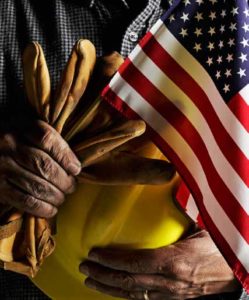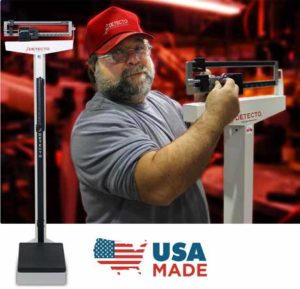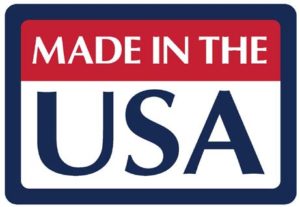How important is ‘Made in the USA’ to your customers?
 Lower total cost. Time-savings. Better patient outcomes. Improved patient experience. What customer doesn’t want to hear these words from their favorite rep’s mouth? Now how about “Made in the USA?” Does that still sell? Manufacturers who build their products in the United States certainly believe so. Repertoire asked them why.
Lower total cost. Time-savings. Better patient outcomes. Improved patient experience. What customer doesn’t want to hear these words from their favorite rep’s mouth? Now how about “Made in the USA?” Does that still sell? Manufacturers who build their products in the United States certainly believe so. Repertoire asked them why.
Responding were:
- Stephanie Wells, director of marketing, Sekisui Diagnostics.
- Harold Chan, senior director of North American operations, Sekisui Diagnostics.
- Cathy Schuch, director of marketing, Graham Medical.
- Darryl Lustig, vice president of distributor relations, Mortara Instrument.
- John Duren, vice president of operations, Mortara Instrument.
- Jonathan Sabo, vice president of marketing, DETECTO.
Repertoire: Are some/most/all of your products manufactured in the United States?
Cathy Schuch: Graham Medical is proud to say that many of our products are made in the USA. Graham Medical is part of the Little Rapids Corporation, a vertically integrated company with our own paper mill, converting facility and printing company. All facilities are located in or near Green Bay, Wisconsin. We have recently added a new machine at our converting facility that will allow us to manufacture existing products here in the U.S. that we were previously outsourcing to other countries.
John Duren: All of our major products are manufactured in the United States, from ECGs and stress systems, to Holter and patient monitors, ensuring a consistent level of excellence. We also offer accessories and supplies manufactured outside the United States. Mortara maintains a rigorous quality process to ensure all products we sell meet the manufacturing standards we set forth.
Jonathan Sabo: We proudly manufacture 94 percent of our products at our USA-made factory in Webb City, Mo. When you buy a product from DETECTO, you’re typically getting it all manufactured under one roof at our production facility in Missouri. Plus, we also offer the convenience of all-American customer service, technical support, aftermarket parts, service repair, and accounting invoicing. DETECTO stands alone as the largest clinical scale manufacturer in the United States. DETECTO has also become much more diverse in the last few years, and we now offer many clinical products beyond scales, such as our new medical crash carts, stadiometers, step-on can waste receptacles, glove box holders, and the new patented HealthySole UVC germicidal disinfection device.
 Repertoire: Do you promote “Made in the USA?” How?
Repertoire: Do you promote “Made in the USA?” How?
Stephanie Wells: Yes we do. We actively promote the fact that one of our product lines – OSOM® rapid tests for use in the physician offices – is made in the USA. We have a “Made in the USA” logo on the reagent kit box, and we have used it in various promotional pieces in the past. Sometimes we actually include the same logo in an ad or sales material.
Cathy Schuch: Graham has recently started increasing our efforts to inform and update our distributors on the products made in the USA so they can relay that message to their customers. The “Made in the USA” logo is placed on all sell sheets and packaging of the items made here. This information is especially useful for distributors if they are working with government businesses or looking to get into that market.
Darryl Lustig: Yes, we even created a campaign centered on this idea for our 30th anniversary: “Built with Pride in Milwaukee.” It’s part of our identity, critical to our business. We want customers and members of the community to know that we made a conscious choice to manufacture products in the U.S.
Jonathan Sabo: Yes, being made in the USA is an important part of who we are as a company and is integral to our company culture. We promote this fact every chance we have from our Detecto.com website, to product brochures, to trade show displays. I would even add that by being USA-made, we gain additional value from being located in the Midwest for our factory, where our employees bring a hard-working Midwestern work ethic and loyalty with them every day that is top-notch. This work ethic and tradition of quality is apparent in the products we make and couldn’t be matched in other parts of the world.
 Repertoire: What are the key benefits of making products in the United States?
Repertoire: What are the key benefits of making products in the United States?
Stephanie Wells: We make the product closer to the customer, so our insight and understanding of our customers’ needs is better. We are able to be more perceptive because we are right here. And when we sell products outside the U.S., we have another advantage: There is a global perception that products made in the United States are of high quality. We also believe that our U.S. distributors appreciate selling U.S.-manufactured products, and there’s a glow effect, because customers recognize that the OSOM brand is manufactured in the United States.
Harold Chan: I see absolute value in producing products closer to the customer. There can sometimes be something lost when trying to service a U.S. company from across the world. Translation issues, lead time to respond with answers, and challenges around product availability make it more difficult. We have to have a highly skilled workforce; that’s the only way we can stay competitive in the United States. Many manufacturers here have embraced Lean Six Sigma – which aligns with the culture of our parent company. We learned a lot from Japan; we can continue to be competitive in the U.S market by embracing some of these principles. It’s a strategy we will continue.
John Duren: The following quote from David Mortara, PhD., founder of Mortara, answers that question: “We are unusual in that we manufacture all of our products in Milwaukee, Wis. We design products in-house. We have an R&D group in Milwaukee and another in Bologna, Italy that collaborate. These designs are ultimately turned into products and shipped throughout the world. Manufacturing in Milwaukee is exciting for us, and we feel strongly that it is not only a good thing to be close to our manufacturing facilities from a quality standpoint, but it is also, quite honestly, a good thing for the community. We have real jobs that we are offering across a diverse set of skills. It is nice to have not just senior talent design engineers, but entry-level assembly people working as part of the team. It feels good as a CEO to be expanding in that area and offering more jobs across that entire spectrum.
“What we have learned, and I am sure others have as well, is that when we look at the labor that it takes to produce a product, that cost is small compared to the total cost of the product. In our devices, this is because there are a significant number of technological components and a comparatively small amount of labor to assemble the products. The nominal higher cost of manufacturing in the U.S. and more specifically, Milwaukee, has a comparatively small impact because the labor content is low. Conversely, if you were to talk about a product where most of the cost was associated with assembly or the labor, and very little of it was associated with the material itself, it might be a harder case to make. In our case, labor is a relatively small content, thanks to the engineering designs that make our products relatively easy to assemble. We see no benefit to offshoring that labor, as a number of our competitors have.”
Jonathan Sabo: There are multiple benefits to being made in the USA for our customers. We can react very quickly to market changes and have done so many times in our company history. If a new feature or improvement is suggested by our customer base, we can incorporate that change into our product design very quickly and seamlessly. Some recent examples of this that come to mind include scale connectivity types, strengthening of column construction, and menu functionality.
Because we are the manufacturer, we don’t have to wait on a hundred thousand-count stock of products from China in a warehouse to sell out before we implement the changes, and we can control our own destiny. As a result, over time our products evolve and improve based on market feedback. Because we employ the whole product cycle in-house from research and development to engineering to manufacturing and finally sales and aftermarket support, we control the entire process and do not have to wait on an overseas factory to work our orders into their own production process.
 Repertoire: What are the challenges of manufacturing products in the United States?
Repertoire: What are the challenges of manufacturing products in the United States?
Harold Chan: Producing in the United States does have its challenges. Probably the single biggest one is the labor cost. As product lines mature, companies tend to move production overseas, because of the lower labor cost.
Stephanie Wells: Meeting market pricing needs is always a challenge in the healthcare market. It’s fair to say we could probably manufacture our product offshore; indeed, many of our competitors do. But the importance to us of having a facility in the United States, whose employees are closer to the customer, offsets some of that higher cost. We also believe we have access to an appropriately skilled workforce. That offsets the import duties we pay other countries.
Jonathan Sabo: The biggest challenges are handling cost for goods based on U.S. wages and U.S. regulations compared to overseas lack of regulation. When you compare a typical production employee salary in the U.S. to a Chinese worker, the cost is going to simply be higher. We have to rely on technological advances, higher work ethic, and better standards of quality to make up the difference sometimes. We also battle against regulations here in the U.S. that cheaper Chinese competitors would not be regulated against. We find that being USA-made wins out over a slightly lower cost by a cheaper Chinese model, especially with clinical scales used in the doctor’s office or hospital for weighing patients, sometimes infants.
Repertoire: Do you recommend that your distributor partners use “Made in the USA” as a selling tool? If so, what would be some talking points? And if not, why not?
Stephanie Wells: We do recommend that. We do our best to convey that there are benefits associated with the use of the “Made in the USA” logo, and that it resonates with the end user customer. Again, there is that perception – actually, reality – of quality.
Cathy Schuch: Our distributors are encouraged to use “Made in the USA” as a selling tool. It is a sign of quality manufacturing, which we are proud to promote.
Darryl Lustig: We encourage distributors to share that our products are manufactured in the U.S, to highlight the reputation of our brands. “Built with Pride in Milwaukee” isn’t just a marketing campaign, it is critical to our business. It is a choice that Mortara has made to keep knowledge and innovation in the U.S., regardless of potential cost savings.
Because our headquarters and manufacturing operations are located in Milwaukee, we have direct oversight of the quality of Burdick, Mortara, Quinton product that is delivered to our customers across the globe. We design in the U.S. We manufacture in the U.S. Keeping design engineers and manufacturing team members together yields higher efficiency, better quality and vastly improved responsiveness. Taken together, these facts trump any perceived economic advantage of outsourcing jobs to low-cost countries.
We believe that this approach is a critical component of our success and sets us apart from our competitors; that manufacturing products in the United States resonates with our customers. It denotes a certain level of quality, and we believe purchasers like to know that they are contributing to the U.S. economy.
Jonathan Sabo: Yes, absolutely. Based on market feedback, the average customer is very interested in made-in-the-USA products. And you would be surprised that this isn’t just happening in the U.S. We receive some of the strongest interest in USA-made products in places you would least expect it, like the Middle East and Asia. Our DETECTO trade show booth at Arab Health in Dubai is heavily attended by Middle Eastern clinical customers who don’t want cheaper Chinese-made products and want USA-made goods.
Repertoire: Do you also offer products made in countries other than the USA? If so, how do you recommend distributor reps promote the benefits of USA-made without damaging the message about your non-USA-made products?
Stephanie Wells: We make products in other markets, including Europe and Japan, and we are a U.S. subsidiary of a Japanese company. As with all of our products, we emphasize the benefits of what we make instead of speaking disparagingly about other products. We always strive to present a fair balance.
Jonathan Sabo: Yes, we also manufacture products made offshore. We vet these manufacturers heavily upfront to ensure they live up to the high standards of quality expected from a DETECTO product. Typically, when we begin the process of product development and assess how best to manufacture a new product, we look at a number of items that are taken into account. What is the finished cost of the product? How complex is the product functionality expected to be? What is the yearly sales volume?
For instance, DETECTO has completely revolutionized our entire digital physician scale line this year, with three new eye-level scales types. For the solo® model, we knew it had to be at a certain low price point and that the scale would be a good quality, but more basic on features. The sales volume was going to be very high, so we elected to use an offshore manufacturer for the solo® that we have worked with many times in the past. We know our new apex® and icon® scales would be using state-of-the-art sonar height rod technology for the electronics and the widest, flattest scale base platforms on the market for the mechanics, so we needed to keep the entire design and production of these new scales in-house. Between the three new product lines, this production flow worked out very well, because we elected where to produce the products based on the market need of features, vs. cost.
Repertoire: Any other comments about “made in the USA?”
Stephanie Wells: We’re very proud of our reputation and the quality of the products we produce; and the fact that we have had strong relationships with distributors over the years, because of the excellence of the products we put in their hands.
Cathy Schuch: Graham is the only vertically integrated supplier in our market that owns a paper mill, resulting in greater quality control and supply chain management from paper to finished product. Our experience in paper dates back to 1894, and Graham Medical has been converting paper for the medical industry for over 40 years. You will have the added value of working with a partner that is established and reliable.
Darryl Lustig: The Burdick, Mortara, Quinton brands have long been recognized as innovative, integrated, and designed to solve the challenges of the clinical environment, as well as simple to operate. We look forward to continuing that tradition for decades to come. Manufacturing products in the United States will be part of that tradition.
The Fourth Industrial Revolution
Manufacturing is going to find its way back to the United States, but it’s going to look a lot different than manufacturing of the past, says Harold Chan, senior director of North American operations, Sekisui Diagnostics.
The wage gap between the United States and developing countries, including China, is narrowing, he points out. Simply put, labor isn’t as cheap in other countries as it used to be. What’s more, the cost of shipping products from Asia to the United States will always be a challenge, particularly as the world’s economies try to cut back on petroleum usage, he says.
When manufacturing does return to the United States, the workforce – and the factories in which they work — won’t be the same, adds Chan. “Workers will be highly skilled, capable of managing new technology and automation.” They will have to be, given new manufacturing processes, which combine technology, automation and the connectedness of the Internet.
“It will be quite exciting to see this transformation,” he continues. Automation becomes more affordable, so does the ability to connect hundreds or thousands of workers via the Internet.
“There’s already a name for it – The Fourth Industrial Revolution,” he says. The First was mechanical power; the second, the assembly line; and the third, 20th century automation, such as robotics. An example of the Fourth? Tesla’s fully integrated manufacturing plant in California.
“I think all companies want to build their products as close to the customer as possible,” he says. Tesla is doing it. “Medical device manufacturers can aspire to do the same.” Integrated manufacturing will make it possible.
Can a company go too far in promoting the red, white and blue?
Repertoire readers may be sipping “America” beer – aka Budweiser – this summer. Some marketing experts believe they may just choke a bit on it.
Anheuser-Busch announced in May that the company would replace the Budweiser logo with “America” on its 12-oz. cans and bottles, through the November election. At press time, it was expected that the new cans and bottles would feature lyrics from “The Star Spangled Banner” and “America the Beautiful.” A picture of the Statue of Liberty was slated to appear on Budweiser’s 16- and 25-ounce cans as well as its 16-oz. bottles.
“On one level, the goal of these changes is obvious,” said Utpal Dholakia, the George R. Brown Professor of Marketing at Rice University’s Jones Graduate School of Business, and a marketing and consumer behavior expert, in a blog in May for Psychology Today.
“Budweiser wants to claim the ‘patriotism’ value in consumers’ minds and gain the loyalty of every American beer drinker who sees himself or herself as patriotic,” he said. However, the brand-name change has produced much consternation and criticism, with marketing experts calling it “shameless” and “a joke,” he said.
“It is one thing to use patriotic illustrations and motifs like flags and fireworks on product packaging or in commercials,” Dholakia wrote. “It is another thing entirely to change one’s brand name for months on end. None of the brands that are seen as more patriotic than Budweiser – whether it is Jeep, Levi’s or Harley Davidson – have changed their names entirely. There is good reason for this. Using research conducted by cognitive psychologists on how people categorize information in their memories and subsequently recall it, marketers have argued that the strongest asset of a brand is its name.”